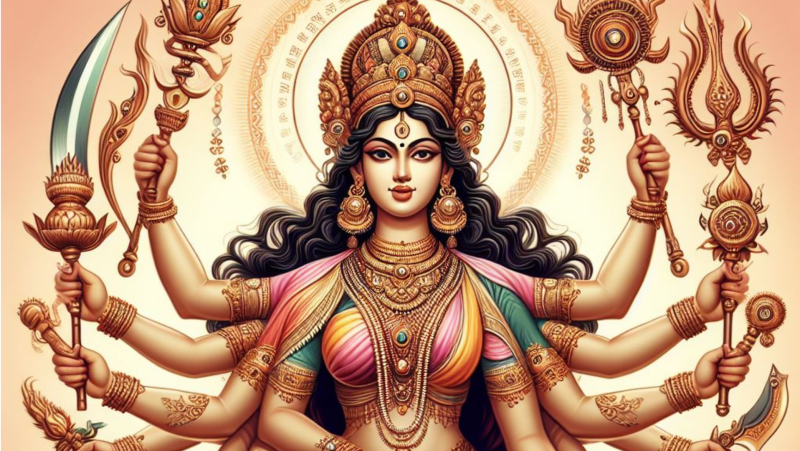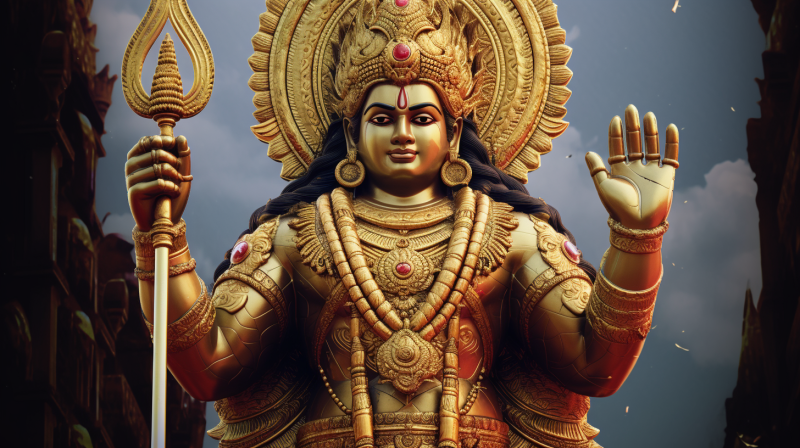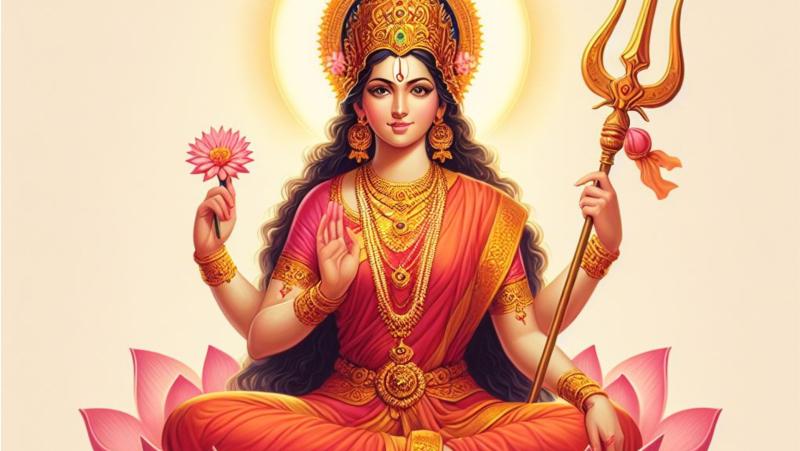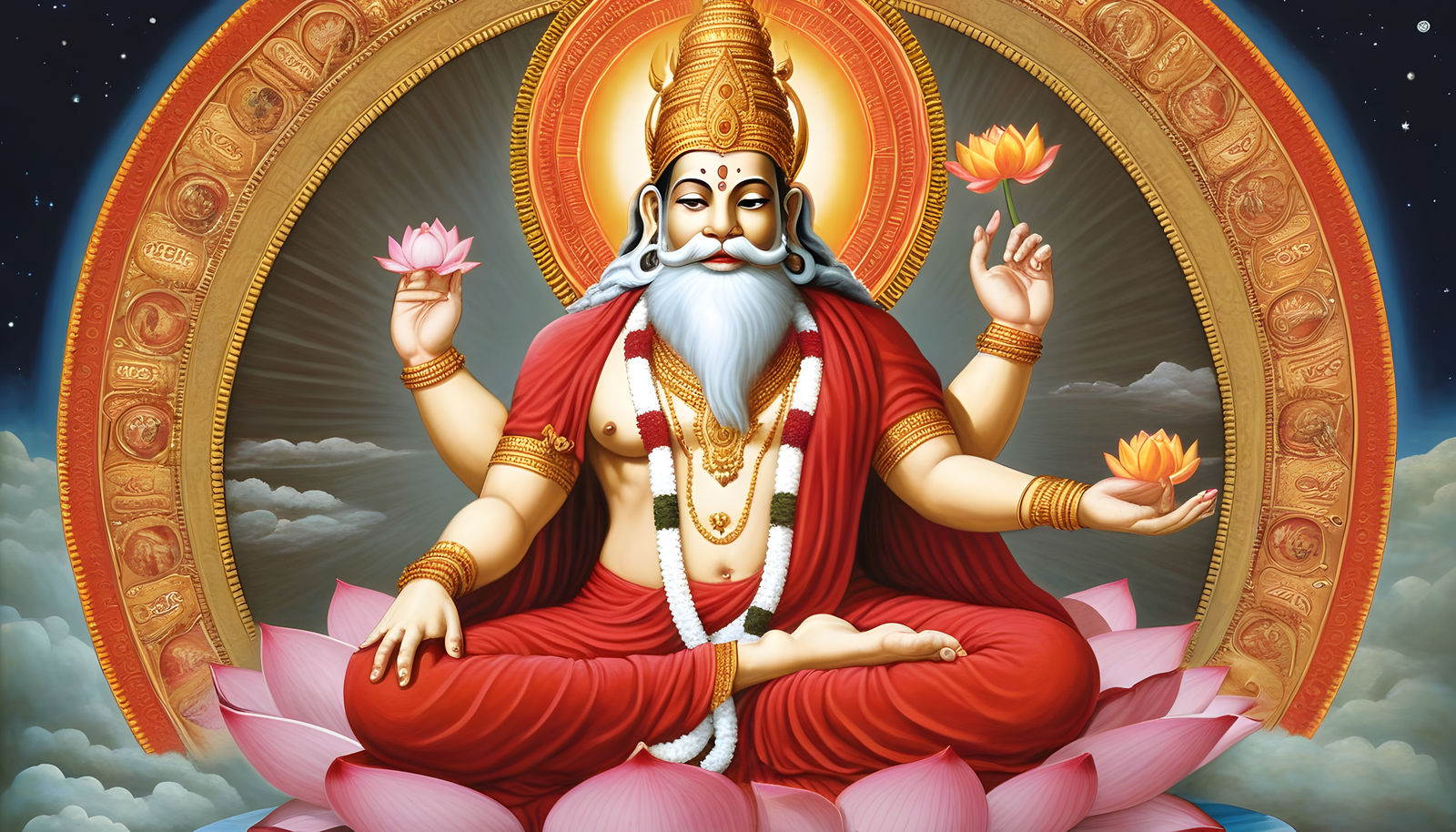
Goddess Lakshmi is a prominent deity in Hindu mythology and is widely revered as the goddess of wealth, prosperity, and good fortune. Her origins and mythology are deeply rooted in Hinduism, and she plays a crucial role in the religious and cultural traditions of India.
Origin of Goddess Lakshmi
The origins of Goddess Lakshmi are deeply rooted in Hindu mythology, and she has a multifaceted history that has evolved over time. Here's a brief overview of her origins:
1. Vedic Origins: The earliest mentions of a goddess similar to Lakshmi can be found in the Vedas, ancient Indian scriptures dating back to around 1500-1200 BCE. In the Vedas, she was associated with fertility, wealth in the form of cattle and grains, and fortune. However, she was not yet identified as the specific goddess we know as Lakshmi today.
2. Emergence in Puranas: The full-fledged characterization of Goddess Lakshmi as we know her today took shape in the later Hindu Puranas, which are post-Vedic texts that elaborate on various aspects of Hindu mythology. These texts provided detailed narratives and attributes to many deities, including Lakshmi.
3. Samudra Manthan (Churning of the Ocean): One of the most famous myths associated with the emergence of Lakshmi is the story of the Samudra Manthan, as mentioned in the Puranas. According to this narrative, the Devas (gods) and Asuras (demons) churned the cosmic ocean in their quest for the nectar of immortality (amrita). During this churning, Goddess Lakshmi emerged from the ocean on a lotus and chose Lord Vishnu as her eternal consort. This event symbolizes the divine connection between wealth and preservation.
4. Consort of Lord Vishnu: Lakshmi's association with Lord Vishnu is central to her mythology. She is often described as his divine spouse and the eternal consort who brings wealth, fortune, and prosperity to his abode.
5. Eight Forms of Lakshmi: In Hindu tradition, Lakshmi is worshiped in various forms, known as the "Ashtalakshmi." Each form represents different aspects of wealth and prosperity, such as financial wealth, knowledge, courage, and victory.
6. Lakshmi in Various Texts: Lakshmi is mentioned in various Hindu texts, including the Mahabharata, Ramayana, and various Puranas, each providing different narratives and aspects of her character.
7. Festivals and Worship: Lakshmi is a central figure in Hindu festivals like Diwali, where she is welcomed into homes with elaborate decorations and offerings. Devotees also observe a special worship ceremony called "Lakshmi Puja" during this time to seek her blessings for wealth and prosperity.
In summary, Goddess Lakshmi's origins can be traced back to the Vedic period, but her full development and characterization as the goddess of wealth, prosperity, and good fortune occurred in the later Hindu Puranas. Her association with Lord Vishnu, her emergence from the churning of the ocean, and her various forms and attributes make her a significant and beloved deity in Hinduism.
Symbolism and Attributes of Goddess Lakshmi
Goddess Lakshmi, the Hindu deity of wealth, prosperity, and good fortune, is rich in symbolism and attributes. She is not only a symbol of material abundance but also represents spiritual prosperity, auspiciousness, and well-being. Here are the key symbolism and attributes associated with Goddess Lakshmi:
1. Lotus (Padma): The lotus is one of the most prominent symbols associated with Lakshmi. She is often depicted seated or standing on a fully blossomed lotus flower. The lotus represents purity, beauty, and enlightenment. Just as the lotus rises above the muddy waters, Lakshmi's blessings bring prosperity and spiritual growth amidst life's challenges.
2. Four Arms: In her iconic form, Lakshmi is depicted with four arms, each symbolizing different aspects of life and prosperity. These arms are laden with symbolic items:
• The first hand holds a lotus, representing purity and beauty.
• The second hand holds a pot of gold or wealth (known as a "kalasha" or "akshaya patra"), signifying material abundance.
• The third hand is often in the abhaya mudra (gesture of fearlessness), assuring protection and dispelling fear.
• The fourth hand is in the varada mudra (gesture of boon-granting), symbolizing the granting of blessings and wishes.
3. Coins: Sometimes, Lakshmi is shown with cascading gold coins from her hands, symbolizing financial wealth and prosperity.
4. Elephant (Gajalakshmi): In some depictions, Lakshmi is surrounded by elephants, known as Gajalakshmi. The elephants are a symbol of royalty, power, and abundance, and they pour water or milk over her, signifying the continuous flow of prosperity.
5. Colors: The colors red and gold are associated with Lakshmi. Red symbolizes energy and transformation, while gold represents wealth and abundance.
6. Diya (Oil Lamp): Diyas or oil lamps are often lit during festivals and rituals dedicated to Lakshmi. The light of the diya represents the dispelling of darkness (ignorance) and the arrival of wisdom, knowledge, and enlightenment.
7. Swan (Hamsa): The swan is sometimes depicted alongside Lakshmi. It is believed to have the ability to separate milk from water, symbolizing her discerning nature, the ability to distinguish between right and wrong, and to choose what is best for her devotees.
8. Peacock: In some representations, Lakshmi is associated with a peacock, the mount of Lord Murugan. The peacock represents vanity and pride, which Lakshmi helps her devotees overcome.
9. Coins and Wealth: Goddess Lakshmi is the bestower of both material wealth and spiritual wealth. She represents the idea that prosperity should be used for the well-being of oneself and others and that true wealth encompasses both worldly possessions and inner spiritual growth.
10. Auspicious Symbols: Lakshmi is often depicted with other auspicious symbols such as conch shells, symbols of good fortune, and rice grains, symbolizing abundance and sustenance.
In Hinduism, the symbolism and attributes of Goddess Lakshmi serve as a reminder of the importance of both material and spiritual wealth, balance, and the pursuit of prosperity with purity and righteousness. Devotees worship her to seek her blessings for financial success, inner peace, and overall well-being.
Forms and Avatars of Goddess Lakshmi
Goddess Lakshmi, the Hindu deity of wealth and prosperity, is believed to manifest in various forms and avatars to fulfill different roles and aspects of life. These forms and avatars of Goddess Lakshmi are revered in Hinduism, and each has a unique significance. Here are some of the prominent forms and avatars of Goddess Lakshmi:
1. Sri Lakshmi: This is the most common and widely worshiped form of Goddess Lakshmi. She is depicted with four arms and is often shown seated or standing on a lotus. In this form, she symbolizes wealth, prosperity, and well-being. Her four arms represent various aspects of life: dharma (duty), artha (wealth), kama (desire), and moksha (liberation).
2. Mahalakshmi: Mahalakshmi is an expanded and more majestic form of Goddess Lakshmi. She is often depicted with six or eight arms, holding different auspicious symbols and bestowing abundant blessings. Mahalakshmi is celebrated during special festivals and rituals, particularly in South India.
3. Ashtalakshmi: Ashtalakshmi refers to the eight different forms or aspects of Goddess Lakshmi, each representing a specific type of wealth and prosperity:
• Adi Lakshmi: The primordial form, symbolizing the beginning of everything.
• Dhana Lakshmi: The bestower of material wealth and abundance.
• Dhanya Lakshmi: The giver of agricultural wealth and food.
• Gaja Lakshmi: The provider of royal and regal wealth and power.
• Santana Lakshmi: The grantor of fertility and progeny.
• Veera Lakshmi: The source of courage, valor, and strength.
• Vijaya Lakshmi: The giver of victory and success.
• Aishwarya Lakshmi: The embodiment of spiritual wealth and knowledge.
4. Padmavati: Padmavati is considered a regional form of Goddess Lakshmi, particularly venerated in the state of Karnataka. She is often depicted riding a lotus and is associated with purity and abundance.
5. Chanchala Lakshmi: Chanchala means "restless" or "fickle." In this form, Goddess Lakshmi is believed to be constantly moving and changing. Devotees seek her blessings to keep wealth flowing and not stagnate.
6. Kamala: Kamala is another form of Lakshmi, and her name means "lotus." She is associated with purity, beauty, and the blossoming of one's potential, much like a lotus flower.
7. Rajalakshmi: Rajalakshmi is the form of Lakshmi that represents the queenly aspect of wealth and power. She is often depicted with a royal crown and jewels, symbolizing regal prosperity.
8. Vishnupriya: In this form, Lakshmi is celebrated as the beloved and devoted wife of Lord Vishnu. She is the embodiment of devotion, love, and loyalty.
9. Bhudevi and Sridevi: Bhudevi represents the Earth and its natural wealth, while Sridevi represents the wealth and abundance of the heavens. Both are considered companions of Lord Vishnu and, by extension, forms of Goddess Lakshmi.
These forms and avatars of Goddess Lakshmi emphasize her multifaceted nature and her role in bestowing various kinds of wealth, prosperity, and well-being upon her devotees. People worship her in these different forms to seek blessings for specific aspects of their lives or to attain a balanced and prosperous existence.
Significance of Goddess Lakshmi in Diwali Festival
The significance of Goddess Lakshmi in the Diwali festival is profound and central. Diwali, also known as Deepavali, is one of the most important and widely celebrated festivals in Hinduism, and it holds great religious and cultural significance. The festival is celebrated to mark the victory of light over darkness and good over evil, and Goddess Lakshmi plays a crucial role in this symbolism. Here's an explanation of the significance of Goddess Lakshmi in Diwali:
1. Symbol of Prosperity and Wealth: Goddess Lakshmi is revered as the deity of wealth, prosperity, and good fortune. Her presence and blessings are sought during Diwali to ensure financial success and abundance for the coming year. People believe that her grace will bring prosperity and economic well-being to their homes and businesses.
2. Spiritual Significance: While Diwali is associated with material wealth and abundance, it also has spiritual significance. Goddess Lakshmi represents not just material riches but also spiritual wealth and auspiciousness. Her worship is an acknowledgment that true wealth includes inner peace, spiritual growth, and wisdom.
3. Worship of the Divine Feminine: Diwali, in many ways, celebrates the divine feminine aspect of the universe. The festival emphasizes the importance of nurturing, caring, and invoking the blessings of the maternal and nurturing energy represented by Goddess Lakshmi. She is often seen as the compassionate mother who provides for her devotees.
4. Cleansing and Purification: Before Diwali, homes are thoroughly cleaned and decorated to welcome the goddess. This process of cleaning and purifying one's living space is symbolic of cleansing one's mind and heart of negative qualities and making room for positivity and abundance.
5. Illumination and Enlightenment: Diwali is known as the Festival of Lights, and lighting lamps and diyas (oil lamps) is a prominent tradition. It symbolizes the victory of light (knowledge, wisdom) over darkness (ignorance). By inviting Goddess Lakshmi into well-lit homes, devotees seek the light of knowledge, wisdom, and spiritual enlightenment.
6. Community and Family Bonding: Diwali is a time when families come together, exchange gifts, and celebrate with joy and harmony. The worship of Goddess Lakshmi fosters a sense of unity and shared blessings within the family and the community.
7. Business and Financial Prosperity: Many businesses and entrepreneurs also worship Goddess Lakshmi during Diwali to invoke her blessings for commercial success and growth. The festival is considered an auspicious time for financial dealings, and it marks the beginning of the Hindu fiscal year in some regions.
8. Expression of Gratitude: Diwali is an occasion for people to express their gratitude to the goddess for her blessings throughout the year. It is a time to acknowledge the importance of wealth and resources in one's life.
In summary, Goddess Lakshmi's significance in the Diwali festival is multifaceted. She represents the material and spiritual aspects of wealth, abundance, and well-being. Her worship during Diwali reflects the desire for prosperity, the importance of inner transformation, and the celebration of the divine feminine energy that sustains and nurtures all aspects of life.
Worship and Temples of Goddess Lakshmi
Worship of Goddess Lakshmi is an integral part of Hindu religious practice, and there are numerous temples dedicated to her throughout India and in various parts of the world where Hindu communities reside. The worship of Goddess Lakshmi can take place both in homes and in temples. Here's an explanation of how she is worshiped and some notable temples dedicated to her:
Worship of Goddess Lakshmi:
1. Daily Puja: Many Hindu households have a dedicated altar or a small shrine where they perform daily rituals and offer prayers to Goddess Lakshmi. This includes lighting oil lamps (diyas), offering flowers, incense, and sweets, and reciting hymns and mantras dedicated to her.
2. Festive Worship: Special worship of Goddess Lakshmi is conducted during festivals like Diwali, Navaratri, and Varalakshmi Vratam. These festivals often involve elaborate ceremonies, fasting, and special pujas dedicated to seeking her blessings.
3. Abhishekam: In some temples and during special occasions, an abhishekam (ritual bath) of the deity's idol is performed with milk, honey, yogurt, ghee, and water. This is followed by dressing the deity in new clothes and adorning her with jewelry.
4. Sahasranama Stotram: The Lakshmi Sahasranama Stotram is a recitation of 1,000 names of Goddess Lakshmi, offering praise and invoking her blessings.
5. Archana: Devotees offer a variety of offerings, including flowers, fruits, coconuts, and sacred ash, while reciting the 108 names or Ashtottara Shatanamavali of Goddess Lakshmi.
6. Bhajans and Kirtans: Singing devotional songs (bhajans) and hymns in praise of Goddess Lakshmi is another way of showing devotion.
Notable Temples of Goddess Lakshmi:
1. Ashtalakshmi Temple, Chennai: Located in Besant Nagar, Chennai.
2. Mahalakshmi Temple, Mumbai: Located in Mumbai, Maharashtra.
3. Sripuram Golden Temple, Tamil Nadu: Located in Vellore, Tamil Nadu.
4. Dakshineswar Kali Temple, Kolkata: Located in Kolkata.
5. Padmavathi Temple, Tirupati: Located in Tiruchanur, near Tirupati in Andhra Pradesh
6. Vaikom Mahadeva Temple, Kerala: Located in Vaikom, Kerala.
These temples serve as places of pilgrimage and devotion for devotees seeking the blessings of Goddess Lakshmi. They are not only centers of religious significance but also cultural landmarks, reflecting the rich tradition and devotion associated with the goddess of wealth and prosperity.
Spiritual Significance of Goddess Lakshmi
The spiritual significance of Goddess Lakshmi goes beyond material wealth and prosperity, and her worship holds deep spiritual meaning in Hinduism. Here are some aspects of the spiritual significance of Goddess Lakshmi:
1. Material and Spiritual Abundance: Goddess Lakshmi is often depicted as standing on a lotus, symbolizing purity and spiritual awakening. Her presence in one's life is believed to bring not just material wealth but also spiritual abundance. This signifies that true prosperity encompasses inner richness, wisdom, and spiritual well-being.
2. Inner Transformation: The worship of Goddess Lakshmi encourages inner transformation. Devotees seek her blessings to cleanse their minds and hearts of negative qualities like greed, jealousy, and attachment. By letting go of these hindrances, individuals can cultivate qualities such as generosity, compassion, and contentment, which are conducive to spiritual growth.
3. Balancing Material and Spiritual Goals: Goddess Lakshmi's worship represents the idea that one can pursue both material and spiritual goals simultaneously. While she is the goddess of wealth, she is also associated with righteousness (dharma) and liberation (moksha). Devotees seek her guidance to lead a balanced life that harmonizes material pursuits with spiritual evolution.
4. Dharma and Righteousness: The pursuit of wealth and prosperity should align with dharma, or righteousness. Goddess Lakshmi photo is often depicted with Lord Vishnu, who is the preserver of dharma. This reinforces the importance of ethical conduct and moral values in one's pursuit of wealth and success.
5. Goddess of Generosity: Lakshmi is also known as "Danalakshmi," emphasizing her role as the goddess of generosity. Devotees seek her blessings to develop a generous and giving nature. Generosity is considered a virtue on the spiritual path as it promotes selflessness and compassion.
6. Cultivating Gratitude: Worship of Goddess Lakshmi encourages individuals to cultivate gratitude for the blessings they have received. Gratitude is a spiritual practice that fosters contentment and a deeper connection with the divine.
7. Auspiciousness and Positivity: Lakshmi is associated with auspiciousness and positivity. Her presence is believed to dispel negativity, fear, and darkness from one's life. This signifies the removal of ignorance and the awakening of inner wisdom and light.
8. Transcending Material Attachments: While Goddess Lakshmi is associated with wealth, her worship also emphasizes the importance of not becoming overly attached to material possessions. Devotees seek her blessings to transcend the materialistic mindset and attain a higher state of consciousness.
In essence, the spiritual significance of Goddess Lakshmi lies in her ability to guide individuals toward a balanced and harmonious life. She teaches that material wealth and spiritual well-being are not mutually exclusive but can coexist when pursued with righteousness, generosity, and a heart filled with gratitude. Her worship encourages individuals to cultivate inner qualities that are conducive to spiritual growth, leading them toward the ultimate goal of liberation and union with the divine.
You may also like …
Are You The Proud Hindu?
The Trimurti
Create an account to join us and start taking part in conversations.
SIGNIN






